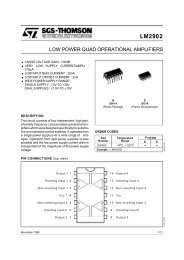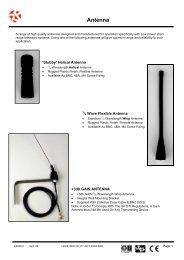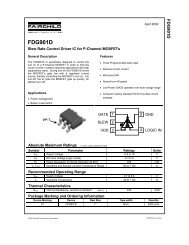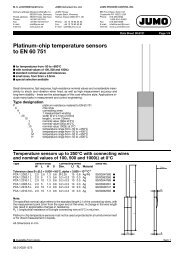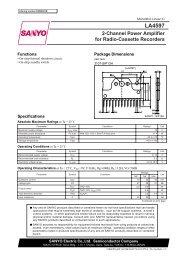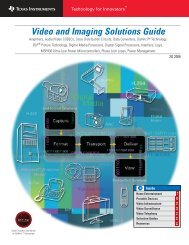DSP Selection Guide
DSP Selection Guide
DSP Selection Guide
You also want an ePaper? Increase the reach of your titles
YUMPU automatically turns print PDFs into web optimized ePapers that Google loves.
TMS320C5000 <strong>DSP</strong> Platform<br />
Silicon<br />
47<br />
➔<br />
TMS320C54x <strong>DSP</strong> Generation, Fixed Point<br />
Power-Efficient Performance <strong>DSP</strong>s<br />
Get samples, datasheets, tools and app reports at: www.ti.com/c5000<br />
Specifications<br />
• 16-bit fixed-point <strong>DSP</strong>s<br />
• Power dissipation as low as 40 mW<br />
• Single- and multi-core products<br />
delivering 30–532 MIPS performance<br />
• 1.2-, 1.8-, 2.5-, 3.3- and 5-V<br />
versions available<br />
• Three power-down modes<br />
• Integrated RAM and ROM<br />
configurations<br />
• Auto-buffered serial port<br />
• Multi-channel buffered serial port<br />
• Host port interface<br />
• Ultra-thin packaging (100-, 128-,<br />
144- and 176-pin LQFPs; 143-, 144-,<br />
176- and 169-pin MicroStar<br />
BGAs)<br />
• 6-channel DMA controller per core<br />
Applications<br />
Digital cellular communications,<br />
personal communications systems,<br />
pagers, personal digital assistants,<br />
digital cordless communications,<br />
wireless data communications, handsfree<br />
car kit, computer telephony, voice<br />
over packet, portable Internet audio,<br />
modems<br />
Features<br />
• Integrated VITERBI accelerator<br />
• 40-bit adder and two 40-bit<br />
accumulators to support parallel<br />
instructions<br />
• 40-bit ALU with a dual 16-bit<br />
configuration capability for dual<br />
one-cycle operations<br />
• 17 × 17 multiplier allowing 16-bit<br />
signed or unsigned multiplication<br />
• Four internal buses and dual<br />
address generators enable multiple<br />
program and data fetches and<br />
reduce memory bottleneck<br />
• Single-cycle normalization and<br />
exponential encoding<br />
• Eight auxiliary registers and a software<br />
stack enable advanced fixedpoint<br />
<strong>DSP</strong> C compiler<br />
• Power-down modes for batterypowered<br />
applications<br />
D(15-0)<br />
A(22-0)<br />
Program/Data ROM<br />
C54x <strong>DSP</strong> CPU<br />
MAC<br />
ALU<br />
17 x 17 MPY<br />
40-Bit ALU<br />
40-Bit Adder CMPS Operator (VITERBI)<br />
RND, SAT<br />
EXP Encoder<br />
Shifter<br />
Accumulators<br />
40-Bit Barrel<br />
40-Bit ACC A<br />
(-16, 31)<br />
40-Bit ACC B<br />
Addressing Unit<br />
8 Auxiliary Registers<br />
2 Addressing Units<br />
Power Management<br />
Program/Data Buses<br />
Program/Data RAM<br />
DMA<br />
JTAG<br />
Emulation<br />
Control<br />
Buffered<br />
Serial Port (BSP)<br />
TDM Serial Port<br />
Multi-channel Buffered<br />
Serial Port (McBSP)<br />
PLL Clock<br />
Generator<br />
S/W Waitstate<br />
Generator<br />
C54x <strong>DSP</strong> Generation Block Diagram<br />
This block diagram of the C54x <strong>DSP</strong> is a comprehensive diagram showing all peripheral options.<br />
C54x <strong>DSP</strong>s are optimized to meet the performance, cost and low-power needs of wireless and<br />
wireline communications systems as well as emerging applications like IP phones, VoP and<br />
portable applications.<br />
Power Management Power Management<br />
2 KWords ROM 64 KWords RAM<br />
Program/Data Buses<br />
C54x <strong>DSP</strong> CPU<br />
128 KWords RAM<br />
C54x <strong>DSP</strong> CPU<br />
Program/Data Buses<br />
DMA<br />
Ch 0<br />
Ch 1<br />
Ch 2<br />
Ch 3<br />
Ch 4<br />
Ch 5<br />
DMA<br />
Ch 0<br />
Ch 1<br />
Ch 2<br />
Ch 3<br />
Ch 4<br />
Ch 5<br />
2 KWords ROM 64 KWords RAM<br />
Ch 0<br />
Ch 1<br />
Ch 2<br />
Ch 3<br />
Ch 4<br />
Ch 5<br />
FIFO Interface<br />
Peripheral Bus<br />
JTAG<br />
Emulation<br />
Control<br />
JTAG<br />
Emulation<br />
Control<br />
Timer<br />
Standard<br />
Serial Port<br />
Host Port<br />
Interface (HPI) 16/8<br />
TMS320C5421 Multicore <strong>DSP</strong> Block Diagram<br />
The C5420 and C5421 <strong>DSP</strong>s are dual-core <strong>DSP</strong>s targeted at carrier-class voice and video end<br />
equipments. The C5441 <strong>DSP</strong> features four C54x <strong>DSP</strong> cores on a single piece of silicon, offering<br />
532 MIPS and is targeted at high-channel density solutions.<br />
Peripheral Bus<br />
Peripheral Bus<br />
Multi-channel Buffered<br />
Serial Port (McBSP)<br />
Multi-channel Buffered<br />
Serial Port (McBSP)<br />
Multi-channel Buffered<br />
Serial Port (McBSP)<br />
16-Bit Timer<br />
2 GP I/O<br />
PLL Clock<br />
Generator<br />
16-Bit HPI<br />
16-Bit HPI<br />
Multi-channel Buffered<br />
Serial Port (McBSP)<br />
Multi-channel Buffered<br />
Serial Port (McBSP)<br />
Multi-channel Buffered<br />
Serial Port (McBSP)<br />
16-Bit Timer<br />
2 GP I/O<br />
PLL Clock<br />
Generator<br />
Texas Instruments 1Q 2007<br />
<strong>DSP</strong> <strong>Selection</strong> <strong>Guide</strong>



